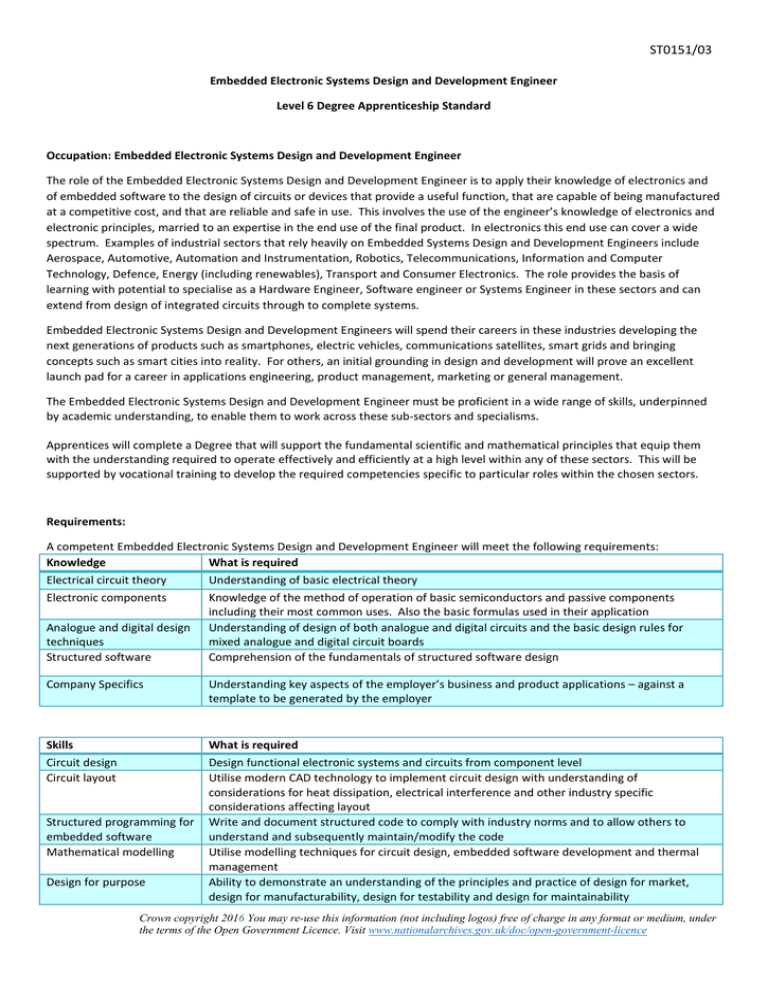Apprenticeship standard for an embedded electronic
advertisement

ST0151/03 Embedded Electronic Systems Design and Development Engineer Level 6 Degree Apprenticeship Standard Occupation: Embedded Electronic Systems Design and Development Engineer The role of the Embedded Electronic Systems Design and Development Engineer is to apply their knowledge of electronics and of embedded software to the design of circuits or devices that provide a useful function, that are capable of being manufactured at a competitive cost, and that are reliable and safe in use. This involves the use of the engineer’s knowledge of electronics and electronic principles, married to an expertise in the end use of the final product. In electronics this end use can cover a wide spectrum. Examples of industrial sectors that rely heavily on Embedded Systems Design and Development Engineers include Aerospace, Automotive, Automation and Instrumentation, Robotics, Telecommunications, Information and Computer Technology, Defence, Energy (including renewables), Transport and Consumer Electronics. The role provides the basis of learning with potential to specialise as a Hardware Engineer, Software engineer or Systems Engineer in these sectors and can extend from design of integrated circuits through to complete systems. Embedded Electronic Systems Design and Development Engineers will spend their careers in these industries developing the next generations of products such as smartphones, electric vehicles, communications satellites, smart grids and bringing concepts such as smart cities into reality. For others, an initial grounding in design and development will prove an excellent launch pad for a career in applications engineering, product management, marketing or general management. The Embedded Electronic Systems Design and Development Engineer must be proficient in a wide range of skills, underpinned by academic understanding, to enable them to work across these sub-sectors and specialisms. Apprentices will complete a Degree that will support the fundamental scientific and mathematical principles that equip them with the understanding required to operate effectively and efficiently at a high level within any of these sectors. This will be supported by vocational training to develop the required competencies specific to particular roles within the chosen sectors. Requirements: A competent Embedded Electronic Systems Design and Development Engineer will meet the following requirements: Knowledge What is required Electrical circuit theory Electronic components Analogue and digital design techniques Structured software Understanding of basic electrical theory Knowledge of the method of operation of basic semiconductors and passive components including their most common uses. Also the basic formulas used in their application Understanding of design of both analogue and digital circuits and the basic design rules for mixed analogue and digital circuit boards Comprehension of the fundamentals of structured software design Company Specifics Understanding key aspects of the employer’s business and product applications – against a template to be generated by the employer Skills Circuit design Circuit layout What is required Design functional electronic systems and circuits from component level Utilise modern CAD technology to implement circuit design with understanding of considerations for heat dissipation, electrical interference and other industry specific considerations affecting layout Write and document structured code to comply with industry norms and to allow others to understand and subsequently maintain/modify the code Utilise modelling techniques for circuit design, embedded software development and thermal management Ability to demonstrate an understanding of the principles and practice of design for market, design for manufacturability, design for testability and design for maintainability Structured programming for embedded software Mathematical modelling Design for purpose Crown copyright 2016 You may re-use this information (not including logos) free of charge in any format or medium, under the terms of the Open Government Licence. Visit www.nationalarchives.gov.uk/doc/open-government-licence ST0151/03 Testing methodology Product transition into production Project Management Compliance Commercial awareness Health and Safety Behaviours Motivation Communication Team ethos and leadership Continuous development Problem solving/practicality Responsibility Ethics and professional standards Ability to develop a test plan for a product that they have developed Ability to explain the process by which a product is introduced into production, including what aspects are discussed at what stage and with whom and how development gateways work Ability to develop a basic project plan including resource planning, time planning, use of contingencies etc. Also techniques for predicting pinch points and strategies for timescale recovery Awareness of international standards and compliance requirements for the products designed by the employer. Ability to discuss the differences between legislative and non-legislative requirements Ability to demonstrate knowledge of basic business fundamentals including costs, overheads, gross margin, net margin, profit, and cash Ability to demonstrate awareness and understanding of basic health and safety principles both in the general workplace and specific to electronic circuit design What is required Self-starter, organised thinker. Works safely and effectively without close supervision Confident in oral, written and electronic methods. Ability to communicate effectively with all levels of stakeholder Exhibits leadership behaviour and qualities. Demonstrable ability to work as a member of a team. Committed to personal learning and development Enjoys problem solving. Able to demonstrate practical capabilities in their professional role. Accepts responsibility for own work and that of others Exercises responsibilities in an ethical manner and respects and complies with company rules and guidelines. Able to commit to beliefs, goals, and standards of their employer and the wider industry and its professional standards Duration: The duration of this apprenticeship is unlikely to be less than 36 months. Entry Requirements: Individual employers will set their own entry requirements in terms of prior academic qualifications and experience. Typically candidates will have attained A-Level standard or equivalent, in Maths and at least one further STEM based subject such as Physics, ICT, Computing or Electronics and will have English Language at GCSE (grade C or above). Level: The Apprenticeship Standard is at Level 6. Qualifications: An Honours Degree in Electronics or Electrical & Electronic Engineering which has been accredited by one of the Professional Engineering Institutions licensed by the UK Engineering Council. Apprentices without a Level 2 English and maths must complete this prior to taking the end-point assessment. Professional Registration: Completion of the Apprenticeship will be recognised by the relevant Professional Engineering Institutions. Review: The standard will be initially reviewed after three years to ensure it reflects employer demand for changes in the syllabus. Crown copyright 2016 You may re-use this information (not including logos) free of charge in any format or medium, under the terms of the Open Government Licence. Visit www.nationalarchives.gov.uk/doc/open-government-licence



